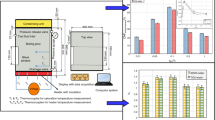Abstract
In this study, pool boiling heat transfer coefficients (HTCs) and critical heat fluxes (CHF) are measured on a smooth square flat copper heater in a pool of pure water with and without carbon nanotubes (CNTs) dispersed at 60°C. Tested aqueous nanofluids are prepared using multi-walled CNTs whose volume concentrations are 0.0001, 0.001, 0.01, and 0.05%. For the dispersion of CNTs, DISPERBYK 184 is used in distilled water. Pool boiling HTCs are taken from 10 kW/m2 to critical heat flux for all tested fluids. Test results show that the pool boiling HTCs of the nanofluids are lower than those of pure water in entire nucleate boiling regime. On the other hand, critical heat flux is enhanced greatly showing up to 150% increase at the CNT concentration of 0.001% as compared to that of pure water. This is related to the change in surface characteristics by the deposition of CNTs. This deposition makes a thin CNT layer on the surface and the active nucleation sites of the surface are decreased due to this layer. The thin CNT layer acts as the thermal resistance and also decreases the bubble generation rate resulting in a decrease in pool boiling HTCs. The same layer, however, decreases the contact angle on the test surface and extends the nucleate boiling regime to very high heat flux range and reduces the formation of large vapor canopy at near CHF. Thus, a significant increase in CHF results.
Similar content being viewed by others
References
J. A. Eastman, S. U. S. Choi, S. Li, L. J. Thompson and S. Lee, Enhanced thermal conductivity through the development of nano-fluids, Proceedings of Symposium on Nanophase and Nanocomposite Materials II, Materials Research Society, Boston, USA 457 (1997) 3–11.
S. Lee, S. U. S. Choi, S. Li and J. A. Eastman, Measuring thermal conductivity of fluids containing oxide nanoparticles, ASME Journal of Heat Transfer, 121 (1999) 280–289.
P. Keblinski, J. A. Eastman and D. G. Cahill, Nanofluids for thermal transport, Materials Today, 8 (2005) 36–44.
X. Wang and A. S. Mujumdar, Heat transfer characteristics of nanofluids: a review, International Journal of Thermal Sciences, 46 (2007) 1–19.
J. A. Eastman, S. U. S. Choi and W. Yu, Anomalously increased effective thermal conductivity of ethylene glycolbased nanofluids containing copper nanoparticles, Applied Physics Letters, 78 (2001) 718–720.
S. K. Das, N. Putra, P. Thiesem and W. Roetzel, Temperature dependence of thermal conductivity enhancement for nanofluids, ASME Journal of Heat Transfer, 125 (2003) 567–574.
S. M. You, J. H. Kim and K. H. Kim, Effect of nanoparticles on critical heat flux of water in pool boiling heat transfer, Applied Physics Letters, 83 (2003) 3374–3376.
I. C. Bang and S. H. Chang, Boiling heat transfer performance and phenomena of Al2O3-water nanofluids from a plain surface in a pool, International Journal of Heat and Mass Transfer, 48 (2005) 2407–2419.
S. J. Kim, I. C. Bang, J. Buongiorno and L. W. Hu, Surface wettability change during pool boiling of nanofluids and its effect on critical heat flux, International Journal of Heat and Mass Transfer, 50 (2007) 4105–4116.
J. S. Coursey and J. Kim, Nanofluid boiling: The effect of surface wettability, International Journal of Heat and Fluid Flow, 29 (2007) 1577–1585.
H. D. Kim, J. Kim and M. H. Kim, Experimental studies on CHF characteristics of nano-fluids at pool boiling, International Journal of Multiphase Flow, 33 (2007) 691–706.
P. M. Ajayan, Nanotubes from carbon, Chemical Reviews, 99 (1999) 1787–1799.
M. S. Dresselhaus, G. Dresselhaus and P. Avouris, Carbon nanotubes: Synthesis, Structure, Properties and Applications, Vol. 80, Springer, New York, USA (2001).
R. H. Baughman, A. A. Zakhidov and W. A. de Heer, Carbon nanotubes — the route toward applications, Science, 297 (2002) 787.
K. J. Park and D. Jung, Enhancement of nucleate boiling heat transfer using carbon nanotubes, International Journal of Heat and Mass Transfer, 50 (2007) 4499–4502.
S. K. Das, N. Putra and W. Roetzel, Pool boiling characteristics of nanofluids, International Journal of Heat and Mass Transfer, 46 (2003) 851–862.
S. K. Das, N. Putra and W. Roetzel, Pool boiling of nanofluids on horizontal narrow tubes, International Journal of Multiphase Flow, 29 (2003) 1237–1247.
R. L. Webb, Principles of enhanced heat transfer, John Wiley & Sons. Inc., New York, USA (1994).
S. J. Kline and F. A. McClintock, Describing uncertainties in single-sample experiments, Mechanical Engineering, 75 (1953) 3–9.
W. M. Rohsenow, A method of correlation heat-transfer data for surface boiling of liquids, ASME Transactions, 74 (1952) 969–976.
N. Zuber, Hydrodynamic aspects of boiling heat transfer. AEC Report no. AECU-4439, Physics and Mathematics (1959).
Y. Fukada, I. Haze and M. Osakabe, The effect of fouling on nucleate pool boiling of small wires, Heat Transfer-Asian Research, 33 (2004) 316–329.
S. G. Kandlikar, A theoretical model to predict pool boiling CHF incorporating effects of contact angle and orientation, ASME Journal of Heat Transfer, 123 (2001) 1071–1079.
Author information
Authors and Affiliations
Corresponding author
Additional information
This paper was recommended for publication in revised form by Associate Editor Yong Tae Kang
Dongsoo Jung is currently a professor in mechanical engineering at Inha University. His primary research interests are refrigeration and heat pumping system design and experimental two phase heat transfer.
Rights and permissions
About this article
Cite this article
Park, KJ., Kang, DG., Jung, D. et al. Nucleate boiling heat transfer in nanofluids with carbon nanotubes up to critical heat fluxes. J Mech Sci Technol 25, 2647–2655 (2011). https://doi.org/10.1007/s12206-011-0742-z
Received:
Revised:
Published:
Issue Date:
DOI: https://doi.org/10.1007/s12206-011-0742-z




